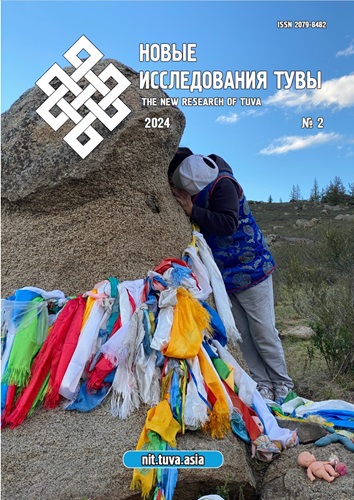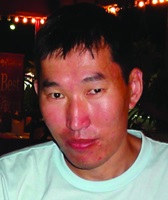Transformation of transport accessibility and tourism development in Todzhinsky kozhuun of the Republic of Tuva
DOI:
https://doi.org/10.25178/nit.2024.2.12Keywords:
remote territory; indigenous peoples of Siberia; tourism; transport remoteness; transport accessibility; Todzhinsky kozhuun; TuvaAbstract
The article reveals the patterns of social processes in the interactions and mutual influence influences between the development of tourism, transport infrastructure and the local community in the Todzhinsky kozhuun of the Republic of Tuva. Interest in this territory is due to significant changes associated with completion of the Kyzyl — Toora-Khem Road in 2009 and the recent opening of the bridge connecting the banks of the Great Yenisei in 2022. Various details of the study were established using a set of sociological and statistical methods. Also, during the study, the attitude of society to the ongoing changes in the field under consideration was recorded.
The actual problem lies in the fact that contradictions often arise between the participants involved in the process of implementation of territorial and sectoral development plans. Possible disagreement is conditioned by multidirectional interests (individual and group) of multiple representatives of different parties. Characteristic contradictions are manifested in the attitude of the indigenous population of remote territories to the development of tourism.
The authors identified a number of populations with diverse interests with diverse interests, demonstrating different attitudes to the problem being covered: representatives of the administration — both with optimism and the prospect of economic development, and with additional preventive work; representatives of public sector institutions and pensioners — with caution, but understanding greater accessibility to medical and educational services; representatives of organizations directly or indirectly related to the service of tourists — with the possibility of obtaining additional income; representatives of organizations not related to tourism — the population is neutral without competition; those not related to tourism are twofold, contradictory, with an understanding of both the advantages in the development of transport links and the disadvantages of the impact on the cultural and natural environment.
References
Berman, N. D. (2020) Influence of transport infrastructure on sustainable development: trends and challenges. International Journal of Advanced Studies, no. 2 (10), pp. 7–14. (In Russ.). DOI: https://doi.org/10.12731/2227-930X-2020-2-7-14
Vainshtein, S. V. (1961) Tuvan-Todzhin people. Moscow, Izatel'stvo vostochnoi literatury. 215 p. (In Russ.).
Dabiev, D. F. and Dabieva, U. M. (2015) Socio-economic characteristics of the Todzhinsky district of Tuva. Mezhdunarodnyi zhurnal prikladnykh i fundamental'nykh issledovanii, no. 9 (3), pp. 520–522. (In Russ.).
Davaa, E. K. (2017) The cultural system of the Tuvan-Todzhin people (late XIX — early XX centuries). Istoricheskie, filosofskie, politicheskie i iuridicheskie nauki, kul'turologiia i iskusstvovedenie. Voprosy teorii i praktiki, no. 4, pp. 62–64. (In Russ.).
Kaznacheev, D. A. (2012) The impact of transport infrastructure on the development of the region's economy. Nauchno-tekhnicheskie vedomosti Sankt-Peterburgskogo gosudarstvennogo politekhnicheskogo universiteta. Ekonomicheskie nauki, no. 2(2), pp. 64–69. (In Russ.).
Kuklina, V. V. and Dashpilov, Ts. B. (2013) Designing a map of the transport connection of the “Sayan crossroads”. Tartaria Magna, no. 2, pp. 12–40. (In Russ.).
Lamazhaa, Ch. K. (2014) Zasayan Tuvans: lifestyle, values, ideals. New research of Tuva, no. 3, pp. 152–165. (In Russ.).
Lamazhaa, Ch. K. (2017) Sub-ethnic groups of the Tuvans : problems of definition and research. New research of Tuva, no. 1, pp. 4–21. (In Russ.). DOI: https://doi.org/10.25178/nit.2017.1.1
Mongush, M. V. (2010) One nation: three destinies. Tuvans of Russia, Mongolia and China in a comparative context. Osaka, Natsional'nyi muzei etnologii. 358 p. (In Russ.).
Ragulina, M. V. (2014) Traditional nature management of the indigenous peoples of Siberia: trends and paradoxes of development. Izvestiia Irkutskogo gosudarstvennogo universiteta, vol. 7, pp. 116–128. (In Russ.).
Rassadin, I. V. (2005) Economy, life and culture of the Tofalars. Ulan-Ude, Buriatskii nauchnyi tsentr Sibirskogo otdeleniia RAN. 190 p. (In Russ.).
Frolova, E. V., Rogach, O. V., Riabova, T. M. (2020) Activities of municipal authorities in the development of cultural and educational tourism: problems, resources and new opportunities. Public Administration Issues, no. 3, pp. 210–228. (In Russ.).
Cresswell, T. (2006) The Right to Mobility: The Production of Mobility in the Courtroom. Antipode, no. 38, pp. 735–754. DOI: https://doi.org/10.1111/j.1467-8330.2006.00474.x
Dirin, D. A. and Fryer, P. (2020) The Sayan borderlands: Tuva’s ethnocultural landscapes in changing natural and sociocultural environments. Geography, Environment, Sustainability, no. 13 (1), pp. 29–36. DOI: https://doi.org/10.24057/2071-9388-2019-76
Dirin, D., Rasputina, E., Kuklina, M., Krasnoshtanova, N., Trufanov, A., Batosirenov, E. and Lysanova, G. (2023) Potential for Tourism and Recreation in the Todzhinsky Kozhuun (District), Republic of Tyva, RF. Sustainability, no. 15, p. 11087. DOI: https://doi.org/10.3390/su151411087
Donahoe, B. (2006) Who Owns the Taiga? Inclusive vs. Exclusive Senses of Property among the Toju and Tofa of Southern Siberia. Sibirica, no. 5, pp. 87–116.
Forbes, B., Stammler, F., Kumpula, T., Meschtybd, N., Pajunena, A. and Kaarlejarvi, E. (2009) High resilience in the Yamal-Nenets social–ecological system, West Siberian Arctic, Russia. In: Proceedings of the National Academy of Sciences of the United States of America, vol. 106, pp. 22041–22048. DOI: https://doi.org/10.1073/pnas.0908286106
Konstantinov, Yu. (2009) Roadlessness and the Person: Mode of Travel in the Reindeer Herding Part of the Kola Peninsula. Acta Borealia, no. 1, pp. 27–49. DOI: https://doi.org/10.1080/08003830902951524
Published
How to Cite
For citation:
Kuklina M. V., Krasnoshtanova N. E., Dirin D. A., Bogdanov N. V. and Trufanov A. I. Transformation of transport accessibility and tourism development in Todzhinsky kozhuun of the Republic of Tuva. New Research of Tuva, 2024, no. 2, pp. 193‑208. (In Russ.). DOI: https://doi.org/10.25178/nit.2024.2.12
Issue
Section

This work is licensed under a Creative Commons Attribution-NonCommercial 4.0 International License.

Author(s) license holder(s) grant rights for their work to the journal (grantee of a license) under the simple non-exclusive open license in accordance with Art. 1286.1 «Open license for a research work, work of literature or fine arts», Civil Code of the Russian Federation.
New Research of Tuva publishes articles under the Creative Commons Attribution-NonCommercial license (CC BY-NC).
Since it is an open license, author(s) reserve the right to upload the article to their institutional repository, submit it to another journal (if it allows republications), or republish it on their own website (in full, or in part).
However, several conditions apply here:
a) The republished version must always contain the name(s) and affiliation(s) of the author(s), the original title and the hyperlink to the original version on the New Research of Tuva website;
b) It must be in open access, free of charge, and no category of readers must be in any way whatsoever advantaged over general readership.
c) should the contribution be submitted elsewhere by its author(s) without substantial modification (30% or more of original text unchanged), the body of the article should contain a disclaimer that the original version was published in New Research of Tuva (with a link to the respective page)
The CC-BY-NC is a non-revocable license which applies worldwide and lasts for the duration of the work’s copyright.













